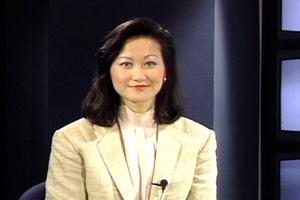
Whitewash, 1990, 14:15 minutes
I thought of WHITEWASH as a landscape work where the environment was television. I found patterns of language and gesture that made up much of television’s content. What might be called “information” or “news” seemed mainly determined by the authority of a way of speaking, a relationship with the camera, the sculpted look and sound of an anchorperson. The same held true for commercials, whose authority was made of bright lighting, bright voices, a choreography of familiar gestures.
In WHITEWASH the markers of television production blur the boundary between commercials and news. The character of an Asian female news anchor is absorbed into this commercial-news continuum, even as she tries to make her way through it, looking for her place in this map of clichés, looking for a way to not be determined by them.
Whitewash was produced at the invitation of the Banff Centre for the Arts as part of the Artists’ Television Workshop